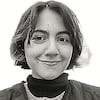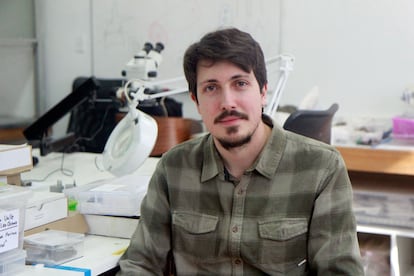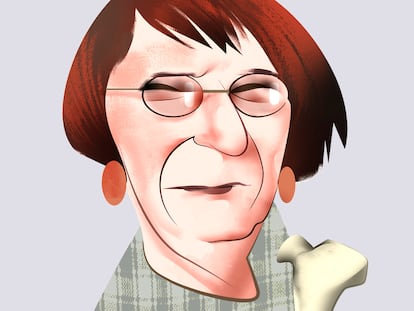Chilean researcher corrects a 159-year-old anatomical error made by Charles Darwin
For more than a century and a half it was believed that a bone piece discovered by the English naturalist corresponded to an animal that inhabited South America 11,000 years ago, ‘Micrauchenia saladensis’

It has taken 159 years for an error made by Charles Darwin to be corrected. Chilean researcher Hans Püschel of the paleontological network of the University of Chile spotted that something did not fit. A single bone — the vertebra supporting the skull — was inscribed within the anatomy of an ancient mammal discovered by Darwin: Micrauchenia saladensis, which coexisted alongside the first humans in South America. However, after comparing it with the rest of the bone remains of this animal, Püschel has now verified that it corresponded to another species — a large bull or cow.
Micrauchenia saladensis was similar to a guanaco — although it does not belong to the same family — weighed in at a ton and is thought to have had a horn at the end of its snout. Like many prehistoric animals, the species was depicted in the animated movie Ice Age (2002). It lived more than 11,000 years ago across a range that covered much of Latin America, including Chile and Argentina.
During Darwin’s Beagle voyage, the English naturalist discovered the remains of Micrauchenia saladensis in Argentina in 1834. The bones of the peculiar animal were taken back to England where they alighted in the laboratory of Richard Owen, founder of the Natural History Museum in London and the creator of the dinosaur concept. He named the animal discovered by Darwin as Macrauchenia, a compound name from the Greek meaning “big neck.”

While conducting a study that allowed him to identify a new species of this same mammal, Püschel was unsure about something. For his analysis, he took as a reference the scientific description of the bones of Micrauchenia made by the German zoologist Herman Burmeister, who settled in Argentina in 1861. Among these was the atlas: the vertebra supporting the skull. Püschel went to several museums seeking information on this species and found that what Burmeister described did not correspond to the skeletal remains of the animal that today is exhibited in the Zoological Museum of the University of Zurich.
“They had an incomplete specimen of Micrauchenia, but with the complete cervical series, part of the skull and parts of the front legs. The interesting thing was, when I saw the atlas, I immediately said ‘this doesn’t look like the atlas that Burmeister described in 1864!’ After that I started to make a detailed study, and I saw that the anatomical features do not match at all and, therefore, the atlas described by Burmeister in 1864 did not correspond to Macrauchenia,” says Püschel. The bone attributed to the species actually corresponded to that of a bovid.
“The importance of this research is that it allows for the correction of a historical error in an emblematic species, which has been very well-studied and included in many works and that, in addition, was discovered by Darwin. So, it is incredible that in all this time the mistake was never corrected, that no one had noticed it. This work resolves that, and it reveals an important anatomical issue in the species,” says Püschel about the finding, which was co-authored with Argentine paleontologist Agustín Martinelli and published in the Swiss Journal of Palaeontology.
Despite this research shedding new light on this curious species, Püschel points out that there is still work to be done: “We need a publication with a kind of monograph or a more detailed work on the whole skeleton, and a more detailed analysis with good images and illustrations, because everything is still very divided in terms of the anatomical issue.”
Sign up for our weekly newsletter to get more English-language news coverage from EL PAÍS USA Edition
Tu suscripción se está usando en otro dispositivo
¿Quieres añadir otro usuario a tu suscripción?
Si continúas leyendo en este dispositivo, no se podrá leer en el otro.
FlechaTu suscripción se está usando en otro dispositivo y solo puedes acceder a EL PAÍS desde un dispositivo a la vez.
Si quieres compartir tu cuenta, cambia tu suscripción a la modalidad Premium, así podrás añadir otro usuario. Cada uno accederá con su propia cuenta de email, lo que os permitirá personalizar vuestra experiencia en EL PAÍS.
¿Tienes una suscripción de empresa? Accede aquí para contratar más cuentas.
En el caso de no saber quién está usando tu cuenta, te recomendamos cambiar tu contraseña aquí.
Si decides continuar compartiendo tu cuenta, este mensaje se mostrará en tu dispositivo y en el de la otra persona que está usando tu cuenta de forma indefinida, afectando a tu experiencia de lectura. Puedes consultar aquí los términos y condiciones de la suscripción digital.










































